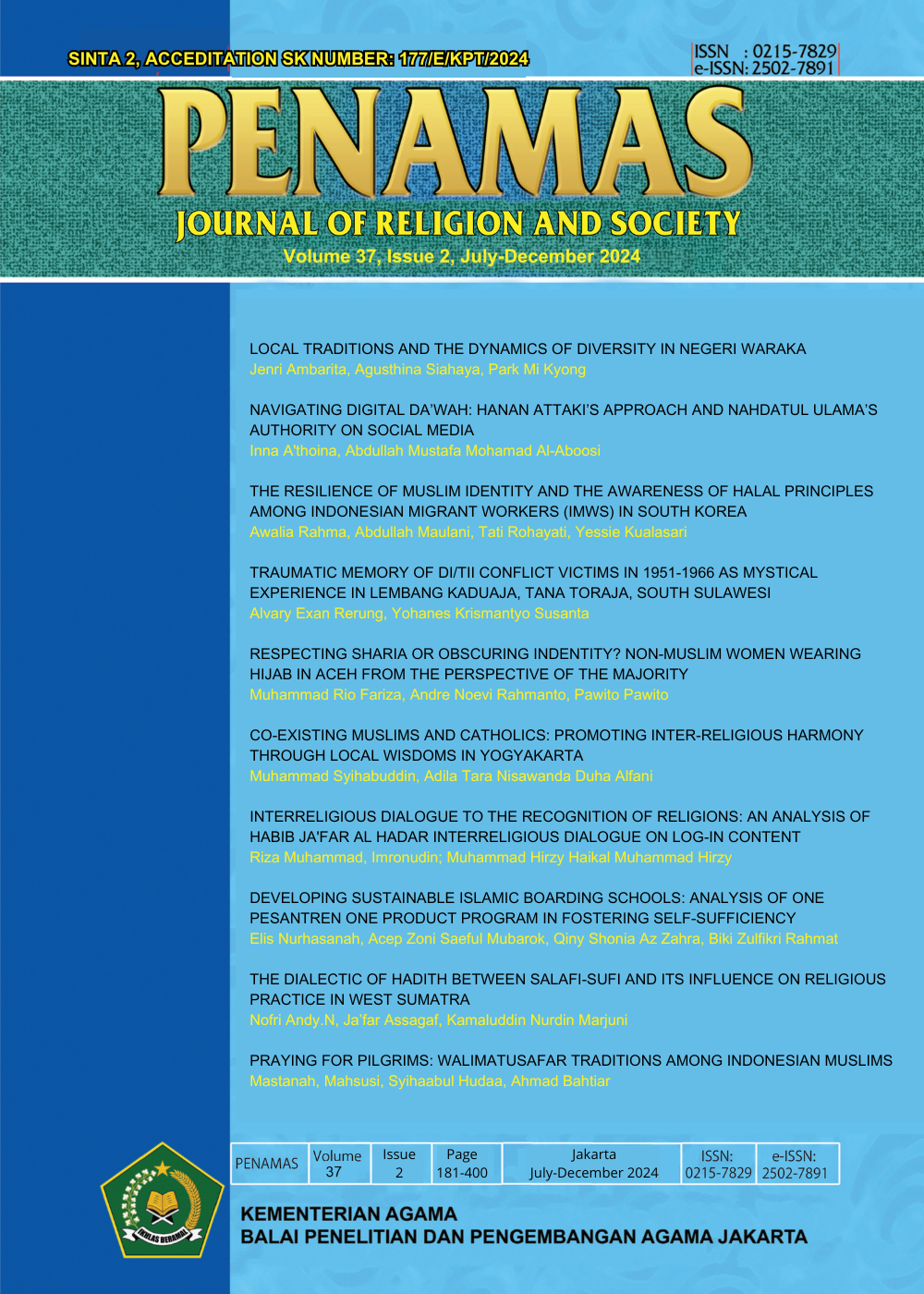RESPECTING SHARIA OR OBSCURING INDENTITY? NON-MUSLIM WOMEN WEARING HIJAB IN ACEH FROM THE PERSPECTIVE OF THE MAJORITY
DOI:
https://doi.org/10.31330/penamas.v37i2.795Keywords:
Hijab, Islamic Sharia, Non-Muslim Women, Majority-Minority, ToleranceAbstract
This study discusses how the majority Muslim community in Aceh responds to the use of the hijab by non-Muslim women in the context of the implementation of Islamic law. The implementation of the Islamic Sharia Qanun in Aceh requires Muslims to wear Islamic clothing. However, it does not apply to non-Muslims, although many non-Muslim women still choose to wear the hijab as a form of social adaptation. Using a qualitative approach and case study method, data were collected through in-depth interviews for one month with eight informants selected by purposive sampling, namely the majority Muslim community in Aceh and those around non-Muslim women who wear the hijab. Symbolic interaction theory analyzes the meaning created by the hijab symbol in social interaction. Gramsci's hegemony theory analyzes the dominance of the majority culture through social consensus without direct coercion. The results of the study show that the majority of Acehnese people accept the use of the hijab by non-Muslim women as a form of respect for local norms and culture. Most informants support this step, although there are concerns about the potential for blurring the identities between Muslims and non-Muslims. This study emphasizes the importance of religious tolerance and moderation to maintain social harmony in areas with religious plurality.
References
Abubakar, A. Y. (2020). Pelaksanaan Syariat Islam Di Aceh Sebagai Otonomi Khusus Yang Simetris. Dinas Syariat Islam Aceh.
Abubakre, F. (2018). Media influences on the perceptions of the usage of hijab in nigeria’s public institutions and surrounding controversy in the lagos-ibadan axis. Journal of Muslim Minority Affairs, 38(4), 521–536. https://doi.org/10.1080/13602004.2018.1544737
Ahmad, K. B. (2014). Islam Dan Kekerasan: Pengalaman Untuk Aceh. Jurnal Ilmiah Peuradeun, 2(3), 67–80. Retrieved from https://journal.scadindependent.org/index.php/jipeuradeun/article/view/40
Aksan, N., Kisac, B., Aydin, M., & Demirbuken, S. (2009). Symbolic interaction theory. Procedia - Social and Behavioral Sciences, 1(1), 902–904. https://doi.org/10.1016/j.sbspro.2009.01.160
Ansor, M., & Mutia, C. I. (2016). “Menjadi Seperti Beragama Lain”:Jilbab dan Identitas Hibrid Mahasiswi Kristen Aceh. Penamas, 29(1), 11–30.
Asri, C., & Ulinnuha, R. (2022). Pengimplementasi Teologi Sosial dalam Memelihara Kerukunan Ummat Beragama di Masyarakat Aceh, 19(2), 343–353. https://doi.org/10.46781/al-mutharahah.
Berger, A. A. (2015). Media and Communication Research Methods. Sage. https://doi.org/10.1007/978-1-137-27225-6
Berutu, A. G. (2020). Formalisasi Syariat Islam Aceh Dalam Tatanan Politik Nasional. Pena Persada.
Blumer, H. (1986). Symbolic interactionism: Perspective and method. Univ of California Press.
Blumer, H. (2004). George Herbert Mead and human conduct. Rowman Altamira.
Blumer, H. (2013). Society as symbolic interaction. In Human behavior and social processes (pp. 179–192). Routledge.
Burke, P. J., & Stets, J. E. (2023). Identity Theory. Oxford University Press.
Carter, M. J., & Fuller, C. (2016). Symbols, meaning, and action: The past, present, and future of symbolic interactionism. Current Sociology, 64(6), 931–961. https://doi.org/10.1177/0011392116638396
Casey, P. M. (2018). Stigmatized Identities: Too Muslim to Be American, Too American to Be Muslim. Symbolic Interaction, 41(1), 100–119. https://doi.org/10.1002/symb.308
Colic-Peisker, V., Mikola, M., & Dekker, K. (2019). Religious visibility: perceptions and experiences of residents in two Muslim concentration suburbs in Melbourne, Australia. Ethnic and Racial Studies, 42(15), 2743–2762. https://doi.org/10.1080/01419870.2018.1557729
Collinge, C., & Hall, S. (2021). Hegemony and Regime in Urban Governance. Transforming Cities, 129–140. https://doi.org/10.4324/9780203991305-13
Coombs, N. C., Campbell, D. G., & Caringi, J. (2022). A qualitative study of rural healthcare providers’ views of social, cultural, and programmatic barriers to healthcare access. BMC Health Services Research, 22(1), 438. https://doi.org/10.1186/s12913-022-07829-2
Cox, R. W. (2005). Gramsci, hegemony and international relations: an essay in method. The Global Resistance Reader, 35–47.
Durst, D. C. (2005). Hegel’s Conception of the Ethical and Gramsci’s Notion of Hegemony. Contemporary Political Theory, 4(2), 175–191. https://doi.org/10.1057/palgrave.cpt.9300112
Fasya, T. K. (2021). Keberagaman Semu dan Dilema Minoritas di Kota Banda Aceh. ISLAM NUSANTARA:Journal for the Study of Islamic History and Culture, 2(1), 71–92. https://doi.org/10.47776/islamnusantara.v2i1.105
Fathorrahman. (2019). Inklusifisme di Tengah Masyarakat Multikultur: Kasus Tiga Komunitas Muslim di Bali. Penamas, 32(1), 589–602.
Fuad, Z., Darma, S., & Muhibbuthabry, M. (2022). Wither Qanun Jinayat? The legal and social developments of Islamic criminal law in Indonesia. Cogent Social Sciences, 8(1), 2053269. https://doi.org/10.1080/23311886.2022.2053269
Gede Agung, D. A., Nasih, A. M., Sumarmi, Idris, & Kurniawan, B. (2024). Local wisdom as a model of interfaith communication in creating religious harmony in Indonesia. Social Sciences & Humanities Open, 9, 100827. https://doi.org/https://doi.org/10.1016/j.ssaho.2024.100827
Hall, P. M. (2017). Structuring Symbolic Interaction: Communication and Power. Annals of the International Communication Association, 4(1), 49–60. https://doi.org/10.1080/23808985.1980.11923793
Hasan, K., & Juhannis, H. (2024). Religious education and moderation: A bibliometric analysis. Cogent Education, 11(1). https://doi.org/10.1080/2331186X.2023.2292885
Hashem, H., Ghani, M., Hirani, S., Bennett, A., & Awad, G. H. (2022). Solo status, religious centrality, and discrimination among American Muslim women. International Journal of Intercultural Relations, 88(May 2021), 32–41. https://doi.org/10.1016/j.ijintrel.2022.03.005
Hidayah, S. (2024). From unity in diversity to culture wars? Aceh women’s mastery over Adat, Islam, and the state inheritance laws. Women’s Studies International Forum, 103, 102881. https://doi.org/https://doi.org/10.1016/j.wsif.2024.102881
Husin, S. S., Ab Rahman, A. A., & Mukhtar, D. (2021). the Symbolic Interactionism Theory: a Systematic Literature Review of Current Research. International Journal of Modern Trends in Social Sciences, 4(17), 113–126. https://doi.org/10.35631/ijmtss.417010
Husni, M., & Kumala, I. D. (2020). Deskriminasi Terhadap Agama Minoritas: Studi Kasus di Banda Aceh. Seurune, Jurnal Psikologi Unsyiah, 3(2), 42–60.
Ichwan, M. N., Salim, A., & Srimulyani, E. (2020). Islam and Dormant Citizenship: Soft Religious Ethno-Nationalism and Minorities in Aceh, Indonesia. Islam and Christian-Muslim Relations, 0(0), 215–240. https://doi.org/10.1080/09596410.2020.1780407
Iqbal, M. (2021). WAJAH BARU PENDIDIKAN ISLAM INDONESIA: Jilbab, Toleransi, dan SKB 3 Menteri. QALAMUNA: Jurnal Pendidikan, Sosial, Dan Agama, 13(2), 201–218. https://doi.org/10.37680/qalamuna.v13i2.864
Ives, P. (2004). Language and hegemony in Gramsci. Pluto Press London.
Jackson, R. L., Drummond, D. K., & Camara, S. (2007). What is qualitative research? Qualitative Research Reports in Communication, 8(1), 21–28. https://doi.org/10.1080/17459430701617879
Jenifer, N. (2012). Gramsci and education. Journal of Romance Studies, 12(3), 90–96. https://doi.org/10.3828/jrs.12.3.90
Juwita, D. R. (2016). Pemberlakuan Hukum Syariat Bagi Warga Non Muslim di Daerah Nangroe Aceh Darussalam (Perspektif Islam dan HAM). El-Wasathiya: Jurnal Studi Agama, 4(1), 23–38.
Kementerian Agama Republik Indonesia, Jumlah Penduduk Menurut Agama, 24 Agustus 2022, https://satudata.kemenag.go.id/dataset/detail/jumlah-penduduk-menurut- agama
Langman, L. (2015). An Overview: Hegemony, Ideology and the Reproduction of Domination. Critical Sociology, 41(3), 425–432. https://doi.org/10.1177/0896920515570208
Lears, T. J. J. (1985). The Concept of Cultural Hegemony: Problems and Possibilities. The American Historical Review, 90(3), 567–593. https://doi.org/10.2307/1860957
Manan, A., & Salasiyah, C. I. (2021). EVALUATING THE IMPLEMENTATION OF SHARIA IN ACEH, INDONESIA (Examining the Qanun Jinayat in Bireuen Regency). Jurnal Ilmiah Peuradeun, 9(3), 549–566. https://doi.org/10.26811/peuradeun.v9i3.593
Mead, G. H., & Morris, C. W. (1972). Mind, Self, and Society. Mind, Self, and Society. https://doi.org/10.7208/chicago/9780226516608.001.0001
Mutaqin, Z. Z. (2018). Culture, Islamic feminism, and the quest for legal reform in Indonesia. Asian Journal of Women’s Studies, 24(4), 423–445. https://doi.org/10.1080/12259276.2018.1524549
Nur, H. B. M. (2020). THE EXISTENCE OF MINORITIES IN THE SPECIFICITY OF ISLAMIC SYIAR IN ACEH , INDONESIA Hasan Basri M . Nur Syed Sultan Bee Packeer Mohamed Nor Azlah Sham Rambely Abstrak Pendahuluan Aceh merupakan wilayah terbarat dan terluar dari kepulauan Indonesia , tepat. Jurnal Al – Bayan, 26(2), 185–215.
Nuriyanto, L. K. (2017). Kerukunan Umat Beragama Di Kota Surakarta: Penamas, 30(2), 145–162. https://doi.org/10.31330/penamas.v30i2.174
Pasha, M. K. (2005). Islam, ‘Soft’ Orientalism and Hegemony: A Gramscian Rereading. Critical Review of International Social and Political Philosophy, 8(4), 543–558. https://doi.org/10.1080/13698230500205235
Pawito. (2007). Penelitian komunikasi kualitatif. Yogyakarta: Pelangi Aksara.
Pirmasari, D. A. (2021). To veil or not to veil? Islamic dress and control over women’s public appearance. Journal of Gender Studies, 30(2), 136–149. https://doi.org/10.1080/09589236.2020.1863199
Prus, R. (2015). Aristotle’s Theory of Deviance and Contemporary Symbolic Interactionist Scholarship: Learning from the Past, Extending the Present, and Engaging the Future. The American Sociologist, 46(1), 122–167. https://doi.org/10.1007/s12108-014-9250-9
Ridwan Nurdin, & Ridwansyah, M. (2020). Aceh, Qanun and National Law. Samarah: Jurnal Hukum Keluarga Dan Hukum Islam, 4(1), 108–131.
Rougier, N. (2013). The hijab in the (denominational) Irish education system–tolerated or accepted? Education Inquiry, 4(1), 149–166. https://doi.org/10.3402/edui.v4i1.22066
Sallach, D. L. (1974). Class Domination and Ideological Hegemony. The Sociological Quarterly, 15(1), 38–50. https://doi.org/10.1111/j.1533-8525.1974.tb02126.x
Sebastian, L. C., & Othman Alkaff, S. H. Bin. (2024). Ideologies and Their Importance in Shaping Islam, Muslims, and Activism in Indonesia BT - Indonesia and Islam in Transition. In L. C. Sebastian & S. H. Bin Othman Alkaff (Eds.) (pp. 71–131). Singapore: Springer Nature Singapore. https://doi.org/10.1007/978-981-97-1140-6_3
Setara Institute, Indeks Kota Toleran 2023, 30 Januari 2024, https://setara- institute.org/indeks-kota-toleran-2023
Sidi, B. A. (2019). Unity and Diversity : National Identity and Multiculturalism in Indonesia. University of Otago, (November), 1–318. Retrieved from https://ourarchive.otago.ac.nz/handle/10523/10106
Smith, R. B. (2017). Symbolic Interaction Theory. The Encyclopedia of Juvenile Delinquency and Justice, 1–4. https://doi.org/10.1002/9781118524275.ejdj0230
Sovacool, B. K., Baum, C. M., & Fritz, L. (2024). Minority groups, Indigenousness and Indigeneity, and place in social perceptions of future climate interventions. World Development, 183, 106719. https://doi.org/https://doi.org/10.1016/j.worlddev.2024.106719
Stoddart, M. C. J. (2007). Ideology, Hegemony, Discourse: A Critical Review of Theories of Knowledge and Power. Social Thought & Research, 28, 191–225. Retrieved from http://www.jstor.org/stable/23252126
Strabac, Z., Aalberg, T., Jenssen, A. T., & Valenta, M. (2016). Wearing the veil: hijab, Islam and job qualifications as determinants of social attitudes towards immigrant women in Norway. Ethnic and Racial Studies, 39(15), 2665–2682. https://doi.org/10.1080/01419870.2016.1164878
Suganda, D. (2014). Pancasila dan Syari’at Islam sebagai Asas Pembentukan Qanun di Aceh. Jurnal Ilmiah Peuradeun, 2(01), 149–164.
Sulaiman. (2018). Studi Syariat Islam di Aceh. Madani Publisher. Banda Aceh.
Syamsuar, Al-Fairusy, M., Junaidi, & Mulia, M. (2023). Settlement of Islamic Sharia Violations in the Perspective of Teungku Dayah and Local Wisdom Values on the West Coast of Aceh. Jurnal Ilmiah Peuradeun, 11(3), 985–1004. https://doi.org/10.26811/peuradeun.v11i3.995
Syarifuddin. (2021). Islamic Plurality in the Perspectives of Ulama Dayah in Aceh. Jurnal Ilmiah Peuradeun, 9(3), 567–586. https://doi.org/10.26811/peuradeun.v9i3.583
Tan, X., Ying, T., Mariska, D., Liu-Lastres, B., Ye, S., & Kim, H. (2022). Residents’ involvement in disaster tourism as a practice: The Case of an Islam destination, Aceh. Annals of Tourism Research, 96, 103467. https://doi.org/https://doi.org/10.1016/j.annals.2022.103467
USCIRF. (2024). United States Commission on International Religious Freedom (Uscirf). UNITED STATES COMMISSION ON INTERNATIONAL RELIGIOUS FREEDOM. https://doi.org/10.1057/978-1-349-96053-8_1246
van Liempt, I., & Miellet, S. (2021). Being far away from what you need: the impact of dispersal on resettled refugees’ homemaking and place attachment in small to medium-sized towns in the Netherlands. Journal of Ethnic and Migration Studies, 47(11), 2377–2395. https://doi.org/10.1080/1369183X.2020.1845130
Walgito, B. (2010). Pengantar Psikologi Umum. Yogyakarta: ANDI.
Yin, R. K. (2018). Case study research and applications: Design and methods. Sage (Vol. 6). https://doi.org/10.1177/109634809702100108
Yuan, M., Yang, Y., & Yi, H. (2023). Environmental condition, cultural worldview, and environmental perceptions in China. Journal of Risk Research, 26(7), 748–777. https://doi.org/10.1080/13669877.2023.2208134
Yusuf, M. Z., & Mutiara, D. (2022). Diseminasi Informasi Moderasi Beragama: Analisis Konten Website Kementerian Agama. Dialog, 45(1), 127–137. https://doi.org/10.47655/dialog.v45i1.535
Downloads
Published
Issue
Section
License
Copyright (c) 2024 Penamas

This work is licensed under a Creative Commons Attribution-NonCommercial-ShareAlike 4.0 International License.









